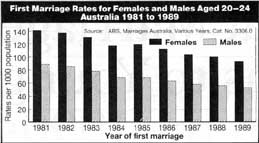Young adults and marriage
A look at the 1980s
You are in an archived section of the AIFS website
August 1991
Abstract
Two sets of ABS data form the basis of a brief discussion about young adults and marriage: figures for 23-year-olds ever married, a term that includes all young adults in a marriage, divorced, or widowed; and first marriage rates for 20-24 year olds.
With the intention of providing general comparative material on marriage for the Institute's Becoming Adult Study, this article focuses on the marriage activity of young adults between 1981 and 1989.
Two sets of ABS data form the basis of a brief discussion about young adults and marriage: figures for 23-year-olds ever married, a term that includes all young adults in a marriage, divorced, or widowed; and first marriage rates for 20-24-year-olds, which calculate numbers entering marriage for the first time per 1000 population of never married women and men in that age group. First marriage rates are used because 20-24-year-olds are considerably less likely to have entered a second or subsequent marriage compared with a first.
Ever Married
The Table shows that the 1980s were characterised by a steady and consistent decline in the proportions of 23-year- old women and men who had ever married. However, the proportions of women of this age who had ever been married were markedly higher than for men. In 1981, almost two- thirds of 23-year-old women had been married compared with just under one-third of men (58 per cent compared with 32 per cent). In fact, the first half of the 1980s saw proportions of 23-year-old women ever married sustained at around the 50 per cent mark compared with around 25 to 30 per cent for men. The latter part of the 1980s saw further reductions in the percentages of young adults ever married, so that by 1989, less than two-fifths of women and less than one-fifth of men had been married (37 per cent and 17 per cent respectively).

The considerable gap between the sexes was maintained throughout the 1980s. Based on a nine-year average for the period 1981 to 1989, approximately 48 per cent of 23-year- old women were ever married compared with around 25 per cent of men. In real terms, almost one-in-two women and one-in-four men had, at some stage, entered the matrimonial labyrinth. Thus, a person was most likely to have been married if they were 23 years of age and a woman, a trend supported by data from the Institute's Becoming Adult Study - women ever married 36 per cent, men ever married 7 per cent.
First Marriage Rate
Consistent with ever married rates, the first marriage rate for women and men between the ages of 20-24 years has also declined. The Figure shows that in 1981, the rate of marriage for never previously married women was about 141 per 1000 compared with about 93 in 1989 (a fall of 34 per cent). For never previously married men, the 1981 rate was about 89 per 1000 compared with about 53 in 1989 (a fall of 40 per cent). The only exception to the general decline was in 1985 when the rate for women increased marginally over the 1984 rate from about 117 per 1000 to about 119 per 1000, while the rate for men remained stable with the 1984 rate of around 68 per 1000.

Dramatically, but not surprisingly (given the rise in the median age at first marriage) illustrated in the Figure, is that women are significantly more likely than men to marry for the first time between the ages of 20-24. Indeed, while the first marriage rates for both women and men have generally decreased, the gap between them has been distinct and was sustained throughout the 1980s, with only minor variations.
The marked distinction between the first marriage rates for women and men is bound up in a complex web of socialisation experiences and community values and expectations, a discussion of which is beyond the scope of this article. Although the first marriage rate has fallen for women and men aged 20-24, findings from the Becoming Adult Study show that this group of 23- year-olds had generally positive responses to marriage and most expected to marry (see accompanying article by Christine Millward).
In summary, the proportions of 23-year-old adults ever married along with first marriage rates for adults aged 20-24 have fallen from 1981 to 1989, with a stronger tendency for women than men to enter marriage when they are in their early twenties.
Finally, while it could be concluded that marriage is becoming less and less popular among young adults, it should be noted that the data are a measure of changing social behaviour which are related to changing social attitudes, but do not necessarily tell us what those attitudes are.
References
- ABS (Australian Bureau of Statistics) (1981 to 1989), Estimated Resident Population by Marital Status, Age and Sex, Australia, Various Years, Catalogue No. 3220.0.
- ABS (1981 to 1989), Marriages Australia, Various Years, Catalogue No. 3306.0.